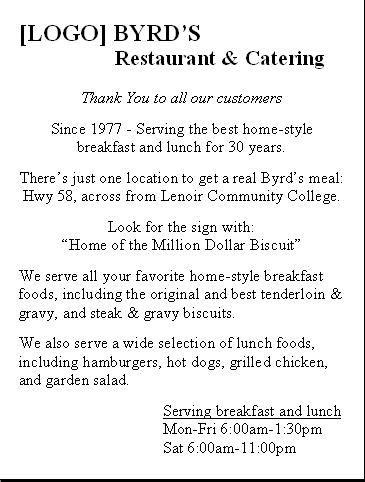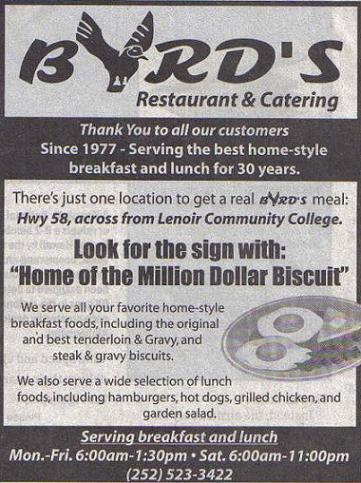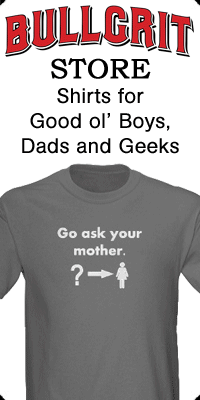Ad Copy
As I’ve mentioned before, my mom owns a small restaurant in my hometown. It’s name is Byrd’s (the original owner’s last name), and it’s fairly popular for its size and location. She and my step-dad did a really good job over the years making it into a great little eatery.
For a couple years, they had a second restaurant inside a convenience store, on the other side of town from the first location. Although it was supporting itself, it was just too much work for them to keep it up. They found a buyer for the location and equipment just before my step-dad passed away. The new owners had an agreement with my step-dad (verbal, “gentlemen’s agreement”) to not use the Byrd’s name and to not serve a tenderloin biscuit (a signature menu item).
Unfortunately, after his death, that agreement was apparently dismissed. Not only do they serve tenderloin biscuits, but their new sign uses the same colors as the Byrd’s sign and logo. (This situation is what prompted the move towards trademarking everything, which I mentioned in an earlier blog post.) Other things, that I won’t go into here, proved to us that the new owners were willing to be at least a little underhanded, despite any earlier agreements. At first glance, it looks like Byrd’s is still in that location.
Recently, my mom asked me to write copy for an ad she was going to run in the local newspaper. I got the information on the ad size, and I asked exactly what she wanted to say.
She wanted to thank the customers, and at the same time she wanted her customers to know that the other restaurant was no longer affiliated with her Byrd’s. Originally, she wanted to state directly that the old second location was not Byrd’s, but I explained a better marketing strategy. After discussing the plan, which she agreed with, I wrote up the ad copy I thought would convey the concept she wanted to get across.
I wrote the text within the size restrictions, and told her to let the newspaper ad department put any graphic-artist touches on it they felt would work. I’ve worked with graphic artists many times, and I respect their abilities as much as I understand my limitations in that area. (Look at this site, for example: lots of text, very little graphic design.) I emailed the Word document to my mom, who forwarded it on to the newspaper ad department.
Here’s the text I wrote (within the actual size of the ad):
Here’s the ad as published (the discolored splotches are from the reverse side of the paper):
I think the ad turned out very nice. I didn’t see the graphic results until I saw the published ad. On my first read through, I noticed two errors.
The “G” in “best tenderloin & Gravy,” shouldn’t be capitalized. Looks like they retyped in my text; I wonder why they didn’t just copy and paste from the Word document? If they did copy and paste, how did that typo get introduced?
The Saturday hours say “6:00 am-11:00pm,” but it should be “11:00am.” (The restaurant closes before noon on Saturday.) Embarrassingly, this mistake was in my original document. Just goes to show, a writer needs an editor to at least proofread everything. I noticed this error immediately upon looking at the ad, but I never noticed it in the three drafts I wrote before sending it off.
The newspaper added the store phone number, probably at my mom’s request. That was a good idea — I should have thought of it.
Bullgrit
bullgrit@totalbullgrit.com






 Categories:
Categories: 







